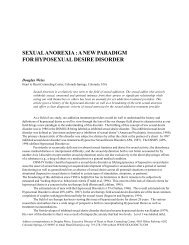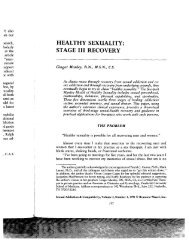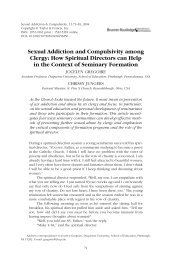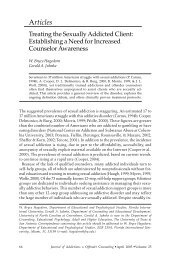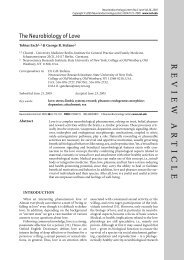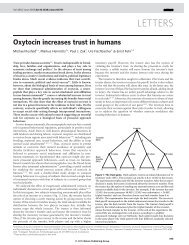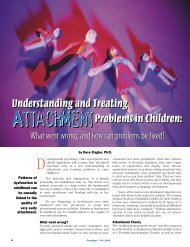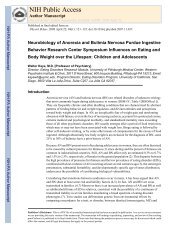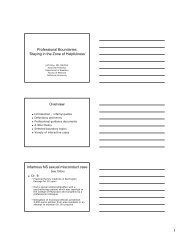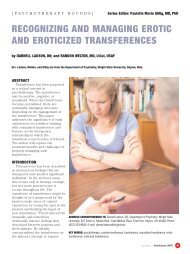An Overview of Psychiatric Ethics
An Overview of Psychiatric Ethics
An Overview of Psychiatric Ethics
You also want an ePaper? Increase the reach of your titles
YUMPU automatically turns print PDFs into web optimized ePapers that Google loves.
Psychiatry and Human Rights2At the time <strong>of</strong> the NT Intervention, the RANZCP issued a press statement expressing its concernat the implications <strong>of</strong> the plan which appeared to lack a long-term perspective to the issues <strong>of</strong> themental health <strong>of</strong> indigenous children and their families. 213 Doubts about the efficacy and ethicalimplications <strong>of</strong> the NT Intervention were also voiced by other medical organizations. Critics <strong>of</strong>the Intervention argued that its paternalistic approach was disrespectful <strong>of</strong> Aboriginal people,undermined their community leadership structures and utterly devalued their culture and communityorder, thus exacerbating the mental and physical health <strong>of</strong> this population. 214 A particularly criticaleditorial was published in the Medical Journal <strong>of</strong> Australia, stating that the NT Intervention wasmeaningless or tokenistic, if the Federal Government failed to support “any national or internationalrequirement or responsibility to recognise and acknowledge native title, cultural integrity, selfdetermination,and preservation <strong>of</strong> Indigenous knowledge and sovereignty”. 215 The AboriginalMedical Services Alliance <strong>of</strong> the Northern Territory (AMSANT) argued that the medical intervention(was) “in serious and ongoing breach <strong>of</strong> medical ethics, including National Health and MedicalResearch Guidelines, Medicare and guidelines on health screening issued by the Royal AustralianCollege <strong>of</strong> General Practice”. 216 AMSANT also expressed concern that the intervention was a “Trojanhorse”, which allowed politically motivated acts, such as scrapping the permit system and theCommunity Development Employment Program (CDEP) and the quarantining <strong>of</strong> welfare payments.Other concerns included preliminary data indicating that by late 2007, only 10% <strong>of</strong> children hadundergone medical examinations. 21737Counter to these arguments was the brutal reality <strong>of</strong> endemic violence and trauma in someAboriginal communities. Regardless <strong>of</strong> the political ramifications <strong>of</strong> taking a position on the NTIntervention, it highlights the problem <strong>of</strong> trauma experienced by indigenous patients and theircommunities.Australian Psychiatry and human rights violationsBackgroundAustralian psychiatry has an ambivalent history. Milton Lewis highlighted this by saying that the1950s Australian psychiatry was not only “divorced from the mainstream <strong>of</strong> medicine” but it wasalso “not a very highly regarded area <strong>of</strong> medical specialisation” (p 99). 218 Two historians havehighlighted that the <strong>of</strong>ficial history <strong>of</strong> the RANZCP 219 has a tone <strong>of</strong> negative self assessment. 220Moreover, psychiatry in Australia has endured a series <strong>of</strong> scandals, either involving moral lapseson the part <strong>of</strong> individual psychiatrists resulting in sexual abuse <strong>of</strong> patients, or in one extraordinaryincident, the murder <strong>of</strong> a senior psychiatrist, Dr Margaret Tobin, by a disgruntled and paranoidcolleague in 2002. 221 More recently, a public scandal involved the failure <strong>of</strong> psychiatrists, workinginside immigration detention facilities, to identify a severely psychotic Australian citizen, CorneliaRau. As Coleborne and MacKinnon note in their history <strong>of</strong> Australian psychiatry “Psychiatry’s public‘image’ is not enhanced by media coverage <strong>of</strong> events such as the internment <strong>of</strong> Cornelia Rau in animmigration detention centre”. 220Chelmsford <strong>Psychiatric</strong> HospitalThe Chelmsford Hospital scandal involved the criminally negligent use <strong>of</strong> the discredited practice <strong>of</strong>continuous narcosis or ‘Deep Sleep Therapy’ (DST). Under the direction <strong>of</strong> a psychiatrist, Dr HarryBailey, and a local general practitioner, Dr Ian Herron, DST was performed at Chelmsford from 1963until the mid-late 1980s. Patients were induced into continuous pr<strong>of</strong>ound sedation with barbiturates,fed through nasogastric tube and administered ECT. Those who did not respond to Bailey’ssatisfaction were referred to a local teaching hospital for cingulotractotomy. Apart from severemedical negligence, Chelmsford Hospital was also culpable in its use <strong>of</strong> inexperienced nurses inthe care <strong>of</strong> such patients. Moreover, when the hospital’s medical board prohibited the use <strong>of</strong> DST,Bailey subverted the process by admitting patients under Herron’s name.After a series <strong>of</strong> complaints, a Royal Commission was established in 1988/89 222 and concludedthat, at the very least, 24 patients had died as a result <strong>of</strong> DST at Chelmsford. <strong>An</strong>other 19 patientswho had undergone DST had committed suicide within a year <strong>of</strong> their admissions to ChelmsfordHospital. Much <strong>of</strong> the agitation about Chelmsford had been by the Church <strong>of</strong> Scientology’s mainanti-psychiatry organ, the Citizen’s Commission <strong>of</strong> Human Rights. Bailey committed suicide in 1985.IMET AN OVERVIEW OF PSYCHIATRIC ETHICS



